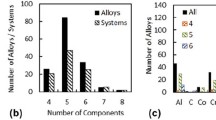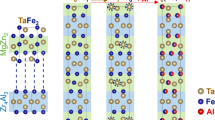Abstract
Neutron diffraction measurement was performed in-situ at high temperatures on Co-Re-Ta-C alloys with and without Cr addition. This included alloys containing different C content with the C/Ta ratio varying between 0.5 and 1.0. The Co-Re-solid solution matrix of the experimental alloys is polymorphic (like in pure cobalt) and transformed from low temperature hexagonal ɛ phase to high temperature cubic γ phase on heating. This transformation is reversible and show hysteresis. The main alloying addition, Re, stabilizes the ɛ Co-phase and increases the transformation temperature to above 1273 K. The onset of the \(\varepsilon \rightleftharpoons \gamma\) transformation during heating and cooling was found to differ depending on the alloy composition. In alloys without Cr addition the transformation was not completed on cooling and the high temperature γ phase was partly retained at room temperature in metastable state with the amount depending on the cooling rate from high temperature. The diffraction and microstructural results showed that Cr is ɛ stabilizer (similar as Re) but the role of Ta is not clear. The C/Ta ratio has no direct effect on the matrix phase transformation. Nevertheless, it influences indirectly by determining the amount of Ta which is freely available in the matrix.
Similar content being viewed by others
References
R. C. Reed, The Superalloys Fundumentals and Applications, pp. 1–31, Cambridge University Press, Cambridge (2006).
J. H. Perepezko, Science 326, 1068 (2009).
J. Rösler, D. Mukherji, and T. Baranski, Adv. Eng. Mater. 9, 876 (2007).
D. Mukherji, J. Rösler, J. Wehrs, P. Strunz, P. Beran, R. Gilles, M. Hofmann, M. Hoelzel, H. Eckerlebe, L. Szentmiklósi, and Z. Mácsik Metall. Mater. Trans. A 44, 22 (2013).
B. Gorr, V. Trindade, S. Burk, H.-J. Christ, M. Klauke, D. Mukherji, and J. Rösler, Oxid. Met. 71, 157 (2009).
L. Wang, B. Gorr, H.-J. Christ, D. Mukherji, and J. Rösler, Oxid. Met. 83, 465 (2015).
D. Coutsouradis, A. Davin, and M. Lamberigts, Mater. Sci. Eng. 88, 11 (1987).
D. Mukherji, M. Klauke, P. Strunz, I. Zizak, G. Schumacher, A. Wiedenmann, and J. Rösler, Int. J. Mater. Res. 101, 340 (2010).
D. Mukherji and J. Rösler, J. Phys. Conf. Ser. 240, 012066 (2010).
D. Mukherji, R. Gilles, L. Karge, P. Strunz, P. Beran, H. Eckerlebe, A. Stark, L. Szentmiklósi, Z. Mácsik, G. Schumacher, I. Zizak, M. Hofmann, M. Hoelzel, and J. Rösler, J. Appl. Crystallogr. 47, 1417 (2014).
J. W. Christian, Proc. R. Soc. A 206, 51 (1951).
C. Hitzenberger, H.P. Karnthaler, and A. Korner, Phys. Status Solidi A 89, 133 (1985).
X. Wu, N. Tao, Y. Hong, J. Lu, and K. Lu, Scr. Mater. 52, 547 (2005).
M. Hansen and K. Anderko, Constitution of Binary Alloys, 2nd ed., p. 805, McGraw-Hill, New York (1958).
K. Shinagawa, H. Chinen, T. Omori, K. Oikawa, I. Ohnuma, K. Ishida, and R. Kainuma, Intermetallics 49, 87 (2014).
D. Mukherji, P. Strunz, R. Gilles, M. Hofmann, F. Schmitz, and J. Rösler, Mater. Lett. 64, 2608 (2010).
J. Singh and S. Rangahathan, Phys. Status Solidi A 73, 243 (1981).
M. Hofmann, R. Schneider, G. A. Seidl, J. Rebelo-Kornmeier, R.C. Wimpory, U. Garbe, Phys. B Condens. Matter. 385-386, 1035 (2006).
M. Hoelzel, A. Senyshyn, N. Juenke, H. Boysen, W. Schmahl, and H. Fuess, Nucl. Instruments Methods Phys. Res. A 667, 32 (2012).
J. Rodríguez-Carvajal, Phys. B Condens. Matter. 192, 55 (1993).
H. M. Rietveld, J. Appl. Crystallogr. 2, 65 (1969).
A. I. Gusev, A. A. Rempel, and A. J. Magerl, Disorder and Order in Strongly Nonstoichiometric Compounds - Transition Metal Carbides, Nitrides and Oxides, p. 455, Springer Verlag, Berlin Heidelberg (2001).
G. Santoro, Trans. Metall. Soc. AIME. 227, 1361 (1963).
L. V. Zueva and A. I. Gusev, Phys. Solid State. 41, 1032 (1999).
N. Wanderka, private communication.
Author information
Authors and Affiliations
Corresponding author
Rights and permissions
About this article
Cite this article
Beran, P., Mukherji, D., Strunz, P. et al. Effect of composition on the matrix transformation of the Co-Re-Cr-Ta-C alloys. Met. Mater. Int. 22, 562–571 (2016). https://doi.org/10.1007/s12540-016-5697-2
Received:
Accepted:
Published:
Issue Date:
DOI: https://doi.org/10.1007/s12540-016-5697-2




